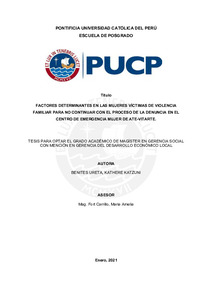| dc.contributor.advisor | Fort Carrillo, María Amelia | |
| dc.contributor.author | Benites Ureta, Kathere Katzuni | |
| dc.date.accessioned | 2021-08-27T18:13:34Z | |
| dc.date.available | 2021-08-27T18:13:34Z | |
| dc.date.created | 2021 | |
| dc.date.issued | 2021-08-27 | |
| dc.identifier.uri | http://hdl.handle.net/20.500.12404/20181 | |
| dc.description.abstract | La violencia contra la mujer, uno de los principales problemas sociales que
aqueja al país, está en aumento. Los feminicidios son recurrentes cada día y para los
agresores ya no son suficientes puñetazos y patadas, ya que ahora han pasado a
acuchillamientos, estrangulamientos, balazos, martillazos; es decir, las agresiones
son cada vez más brutales. No obstante, las medidas adoptadas por el Gobierno
contra esa realidad son insuficientes, como el Programa Nacional para la Prevención
y Erradicación de la Violencia contra las Mujeres e Integrantes del Grupo Familiar -
AURORA que tiene debilidades y vacíos que urge eliminarse con estrategias
articuladoras bien elaboradas y transversales a todos los ministerios y demás
estamentos estatales. Todo ello es necesario, pues la agresión contra la mujer es un
problema que atañe los aspectos económico, social, cultural, educativo y sanitario.
Una de las dificultades observadas en los Centros de Emergencia Mujer
(CEM), fue lograr que las víctimas denuncien los casos de agresión y, sobre todo, que
continúen con dicho proceso. Por ese motivo, en esta investigación, la autora se
planteó el objetivo de identificar los factores determinantes que influyen en la no
continuidad de la denuncia de las mujeres por violencia familiar del CEM de Ate
Vitarte, con énfasis en las causales de índole personal y cultural de las víctimas.
Asimismo, se verificó el nivel de apreciación y el cumplimiento de expectativas
satisfechas e insatisfechas por el CEM evaluando sus procedimientos y plazos con
respecto a las necesidades de las mujeres agredidas e identificando, también, los
factores críticos laborales del equipo especializado que trabaja allí y que limitan el
seguimiento de los casos. El objetivo de todo este análisis es generar una propuesta
de mejora estratégica en los procesos de intervención del CEM de Ate Vitarte.
La metodología empleada en este trabajo fue cualitativa, basada en el estudio
de caso con identificación de los factores que influyen en la no continuidad de la
denuncia en las víctimas de violencia familiar. | es_ES |
| dc.description.abstract | Violence against women, one of the main social problems plaguing the country,
is on the rise. Femicides are recurring every day, and for the aggressors, the punches
and kicks are no longer enough, because, now, they are stabbing, strangling, shooting
and hammering; in other words, the attacks are more and more brutal. Against this,
the measures adopted by the Government are insufficient, and the National Program
for the Prevention and Eradication of Violence against Women and Family Group
Members - AURORA has weaknesses and gaps that need to be filled with articulated
strategies well developed, and cross-cutting to all the ministries and state levels, due
that the aggression against women is a problem that concerns the economic, social,
cultural, educational and health aspects.
One of the difficulties that could be observed in the Emergency Women Centers
(CEM) was getting victims to report cases of aggression and, above all, to continue
with this process. For this reason, in this investigation, the author set out the objective
of identifying the determining factors that influence the non-continuity of the complaint
of women for family violence in the Emergency Women Centers of Ate Vitarte, with an
emphasis on personal and cultural causes of the victims. Furthermore, the level of
appreciation and fulfillment of expectations satisfied and unmet by the CEM was
verified, evaluating its procedures and deadlines with respect to the needs of the
women attacked, as well as identifying the critical labor factors of the specialized team
that works there, which limits case follow-up. This, to generate a proposal for strategic
improvement in the intervention processes of the CEM of Ate-Vitarte.
The methodology used in this work was qualitative, based on the case study
with identification of the factors that influence the non-continuity of complaint in victims
of family violence. | es_ES |
| dc.language.iso | spa | es_ES |
| dc.publisher | Pontificia Universidad Católica del Perú | es_ES |
| dc.rights | info:eu-repo/semantics/openAccess | es_ES |
| dc.rights.uri | http://creativecommons.org/licenses/by-nc/2.5/pe/ | * |
| dc.subject | Violencia contra la mujer-- Perú--Ate-Vitarte (Lima : Distrito) | es_ES |
| dc.subject | Servicios sociales--Administración | es_ES |
| dc.subject | Políticas sociales--Perú | es_ES |
| dc.title | Factores determinantes en las mujeres víctimas de violencia familiar para no continuar con el proceso de la denuncia en el Centro de Emergencia Mujer de Ate-Vitarte | es_ES |
| dc.type | info:eu-repo/semantics/masterThesis | es_ES |
| thesis.degree.name | Magíster Gerencia Social con mención en Gerencia Del Desarrollo Económico Local | es_ES |
| thesis.degree.level | Maestría | es_ES |
| thesis.degree.grantor | Pontificia Universidad Católica del Perú. Escuela de Posgrado | es_ES |
| thesis.degree.discipline | Gerencia Social con mención en Gerencia Del Desarrollo Económico Local | es_ES |
| renati.advisor.dni | 06649671 | |
| renati.advisor.orcid | https://orcid.org/0000-0002-5596-681X | es_ES |
| renati.author.dni | 46527473 | |
| renati.discipline | 314407 | es_ES |
| renati.juror | Tello Vigil De Morales, Gricelda Zosima | |
| renati.juror | Fort Carrillo, Maria Amelia | |
| renati.juror | Zuta Vidal, Erika Irene | |
| renati.level | https://purl.org/pe-repo/renati/level#maestro | es_ES |
| renati.type | http://purl.org/pe-repo/renati/type#tesis | es_ES |
| dc.publisher.country | PE | es_ES |
| dc.subject.ocde | http://purl.org/pe-repo/ocde/ford#5.09.00 | es_ES |






